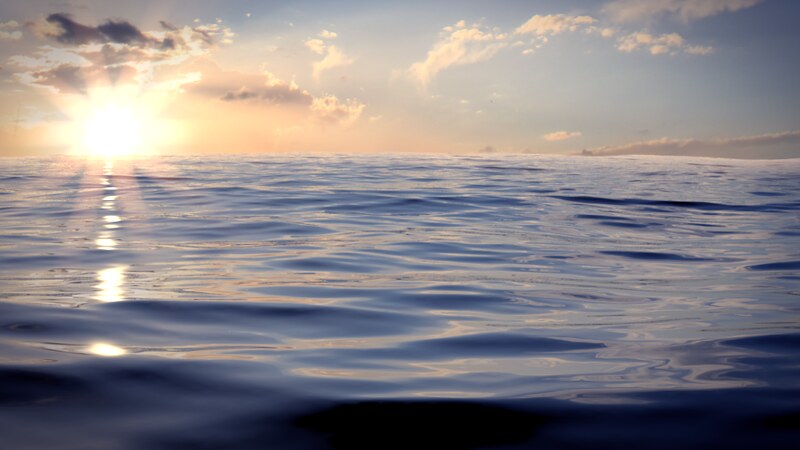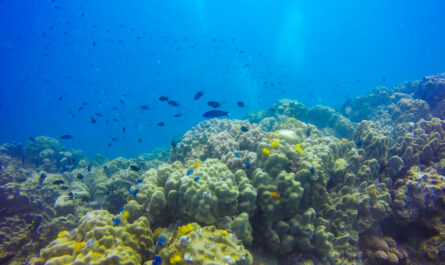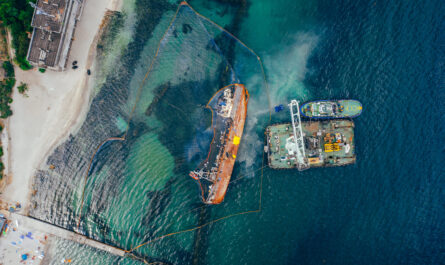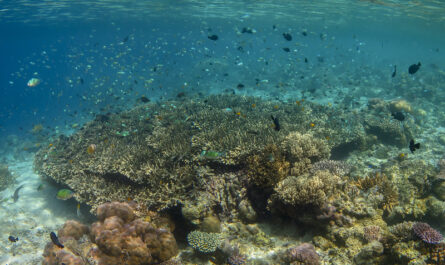The Pacific Ocean, with a vastness that covers more than 63 million square miles and plunges to depths that exceed 36,000 feet, is the largest and deepest ocean on Earth. While much of its surface is well-explored, the true marvel lies in the deep-sea regions—environments that remain largely unknown to humankind. Known as the abyss, these deep-sea regions are filled with towering underwater mountain ranges, deep trenches, and an array of life forms that have evolved in total darkness, under extreme pressure, and often at near-freezing temperatures.
Advancements in deep-sea exploration have begun to reveal the secrets of this mysterious world. From the immense Mariana Trench to hydrothermal vents teeming with unique life, and the unknown impact of human activities like deep-sea mining, the abyss holds a treasure trove of information about Earth’s past, present, and future.
1. The Mariana Trench: Earth’s Deepest Mystery
The Mariana Trench, the deepest known part of Earth’s oceans, is a crescent-shaped trench located in the western Pacific Ocean, east of the Mariana Islands. At its lowest point, the Challenger Deep, the trench plunges nearly 36,000 feet (11,000 meters) below sea level. This remote and inhospitable environment is still one of the least explored places on the planet.
Exploration efforts, including the bathyscaphe Trieste’s historic dive in 1960 and James Cameron’s solo dive in 2012, have unveiled a desolate landscape with soft sediments, volcanic activity, and unique deep-sea organisms adapted to life under extreme conditions. Despite the apparent harshness, microbial life flourishes, and scientists believe there could be more complex forms of life yet to be discovered.
Geological Significance: The trench marks the boundary between two tectonic plates, where the Pacific Plate is subducting beneath the smaller Philippine Sea Plate. This subduction process not only forms the trench but also creates deep-sea earthquakes and volcanic activity, which may provide clues about the Earth’s geology and the movement of tectonic plates over millions of years.
2. Life in the Abyss: Extreme Adaptations
The abyssal zone, which spans from 3,000 to 6,000 meters (9,800 to 19,700 feet) deep, is a region of the ocean characterized by near-freezing temperatures, crushing pressures, and complete darkness. Despite these extreme conditions, life has adapted in incredible ways to survive. Some of the most fascinating adaptations include:
- Bioluminescence: One of the most dramatic adaptations in the deep sea is bioluminescence, a phenomenon where organisms produce light through chemical reactions. This light is used for a variety of purposes: to lure prey, communicate with mates, or confuse predators. The anglerfish is a prime example, with its glowing lure to attract unsuspecting prey in the dark.
- Abyssal Gigantism: Deep-sea species often display a phenomenon known as abyssal gigantism, where creatures such as the giant squid and giant isopods grow to much larger sizes than their shallow-water relatives. The causes of abyssal gigantism are still debated, but it’s thought to be an adaptation to the sparse availability of food in the deep sea, where larger body sizes might offer greater energy storage.
- Slow Metabolism and Longevity: Deep-sea organisms often have much slower metabolisms, which allows them to conserve energy in an environment where food is scarce. This slower metabolic rate also leads to longer life spans; for instance, some deep-sea fish and invertebrates can live for several decades, or even centuries.
- Chemosynthesis: In the absence of sunlight, many deep-sea ecosystems rely on chemosynthesis, a process by which microbes derive energy from chemicals like hydrogen sulfide or methane, released by hydrothermal vents or cold seeps. This is a stark contrast to the energy systems found in shallower waters, where life depends on sunlight and photosynthesis.
3. Hydrothermal Vents: Oases in the Abyss
Perhaps the most extraordinary feature of the deep ocean is the presence of hydrothermal vents. These vents form along mid-ocean ridges and volcanic arcs, where seawater seeps through cracks in the Earth’s crust, is superheated by magma, and then expelled back into the ocean, rich with minerals and chemicals. The ecosystems surrounding these vents are among the most unique on Earth, as they support life entirely dependent on chemosynthesis.
- Black Smokers: The most iconic type of hydrothermal vent, black smokers, spew superheated water rich in minerals like iron and sulfur, which support communities of bacteria that form the foundation of the vent ecosystem. These bacteria, in turn, support larger organisms like tube worms, vent crabs, and vent shrimp. Tube worms, for instance, have no digestive system and rely entirely on symbiotic bacteria for their nutrition, allowing them to thrive in an environment devoid of sunlight.
- Cold Seeps: Similar to hydrothermal vents, cold seeps release chemicals like methane and hydrogen sulfide but at much lower temperatures. These ecosystems support a different range of life, including mussels, clams, and bacteria, which have adapted to use methane as a source of energy.
Hydrothermal vent ecosystems are of particular interest to scientists because they may offer clues about the origins of life on Earth. The ability of organisms to survive in such extreme environments suggests that life could exist in similar conditions on other planets, such as Jupiter’s moon Europa, where sub-surface oceans may host hydrothermal activity.

4. The Hadal Zone: Beyond the Abyss
The hadal zone, the deepest part of the ocean, extends from 6,000 meters (19,700 feet) to the bottom of oceanic trenches, such as the Mariana Trench. The conditions here are even more extreme than in the abyssal zone, with pressures exceeding 1,100 times atmospheric pressure and temperatures close to freezing. Despite these conditions, the hadal zone is not lifeless.
- Hadal Creatures: Species found in the hadal zone, such as the hadal snailfish, are often adapted to these crushing pressures through specialized biochemical processes. The snailfish, for example, has gelatinous bodies and lacks the calcium structures typical of shallow-water fish, allowing it to withstand immense pressure.
- Deep-Sea Sediment and Marine Snow: The hadal trenches accumulate vast amounts of deep-sea sediments, brought down by landslides or washed in from river deltas. These sediments are often rich in organic material, which forms the base of the food chain in the form of marine snow—detritus of dead organisms, fecal matter, and other organic particles that fall through the water column, providing nourishment to life in the deep.
The hadal zone is the least explored part of the world’s oceans, and many believe that it could harbor undiscovered species, unique to the extreme conditions of these trenches.
5. Human Impact: Mining, Pollution, and Conservation
While the deep sea may seem remote and untouched by human activity, it is increasingly being impacted by activities such as deep-sea mining, plastic pollution, and fishing practices.
- Deep-Sea Mining: The Pacific’s abyssal plains are rich in polymetallic nodules, which contain valuable metals like manganese, cobalt, and nickel. These nodules, formed over millions of years, are now targeted by mining companies seeking to extract them for use in electronics, batteries, and renewable energy technologies. However, the ecological consequences of deep-sea mining are largely unknown, and many scientists fear that mining could cause irreversible damage to fragile deep-sea ecosystems before we fully understand them.
- Plastic Pollution: Even the deepest parts of the ocean are not immune to plastic pollution. In recent years, researchers have found plastic debris, including bags and microplastics, at the bottom of the Mariana Trench. The ingestion of plastic by deep-sea creatures poses a serious threat to their health, and it highlights the global reach of the plastic pollution problem.
- Conservation Efforts: Conservation efforts aimed at protecting the deep sea are still in their infancy. However, there are growing calls for the creation of deep-sea marine protected areas (MPAs) and for the regulation of activities such as deep-sea mining. Organizations like the International Seabed Authority (ISA) are working to establish guidelines for sustainable seabed mining, but more comprehensive global regulations are needed to ensure the protection of the deep ocean.
6. The Future of Deep-Sea Exploration
The future of deep-sea exploration is filled with promise. Advances in ROV and AUV technology have allowed scientists to explore the deep sea in ways that were previously unimaginable. Submersibles like the DSV Alvin and ROV SuBastian have already made groundbreaking discoveries, and future missions aim to map the entire ocean floor, collect biological and geological samples, and further investigate the mysteries of the deep.
One of the most exciting prospects is the potential for bioprospecting—the search for**(continued)**:
One of the most exciting prospects is the potential for bioprospecting—the search for novel compounds, enzymes, and microorganisms in the deep sea that could be used in pharmaceuticals, industrial processes, or biotechnology. The deep ocean may harbor extremophiles, organisms that thrive in extreme conditions and possess unique biochemical properties. Such organisms could offer breakthroughs in medicine, particularly in cancer treatment and antibiotic development, as well as in industrial applications.
Future Technologies: Advancements in autonomous underwater vehicles (AUVs), submersibles, and robotics will allow us to explore deeper, longer, and with greater precision. Projects like the Seabed 2030 initiative, which aims to map the entire ocean floor by 2030, are crucial in advancing our understanding of the deep sea. This mapping will not only provide insights into the topography of the abyss but also help identify new ecosystems, geological features, and resources.
Additionally, with the rise of AI and machine learning, vast amounts of data collected from deep-sea expeditions can be analyzed more efficiently. This technology will enable more precise predictions about the distribution of species, the impact of human activities, and potential climate-related changes to deep-sea environments.
7. Studying the Abyss for Insights into Climate Change
The deep sea plays a pivotal role in regulating Earth’s climate. The abyssal plains and trenches act as vast carbon sinks, where carbon dioxide is absorbed and sequestered in sediments for millions of years. The ocean also helps regulate global temperatures by distributing heat through ocean currents, including deep-sea thermohaline circulation. Studying how deep-sea ecosystems respond to climate change can provide critical insights into the long-term effects of global warming and ocean acidification.
Researchers are particularly interested in the impact of rising temperatures on cold-water corals and deep-sea fish species. Changes in water chemistry, particularly from increasing levels of dissolved CO2, can lead to ocean acidification, which weakens the calcium carbonate skeletons of corals and shell-forming organisms, further disrupting the delicate balance of deep-sea ecosystems.
8. Deep Sea: A Final Frontier for Humanity
The deep sea remains one of the last frontiers on Earth. With more than 80% of the ocean still unmapped and unexplored, the secrets of the abyss hold untold potential for scientific discovery and understanding of our planet. As technology continues to advance, humanity is poised to uncover the mysteries of the Pacific Ocean’s abyss, not only for the sake of knowledge but also for the survival and health of our planet.
Protecting this last frontier is crucial, as the deep sea represents not just the ancient history of Earth but also the future of science, medicine, and our understanding of life itself. The abyss is a testament to life’s ability to adapt and thrive under even the harshest conditions, offering hope for exploration both on our planet and beyond.
Conclusion: The Pacific Ocean’s abyss is a world of extremes, filled with ancient mysteries and life forms that challenge our understanding of biology, geology, and the adaptability of life. From the Mariana Trench’s incredible depths to the unique ecosystems surrounding hydrothermal vents, the secrets of the deep sea continue to intrigue scientists and explorers alike. However, as human activities like deep-sea mining and plastic pollution threaten these fragile ecosystems, the race to explore and protect the abyss has never been more urgent. The future of deep-sea exploration holds limitless potential, not only for scientific discovery but also for the conservation of one of Earth’s most important and least understood ecosystems.



